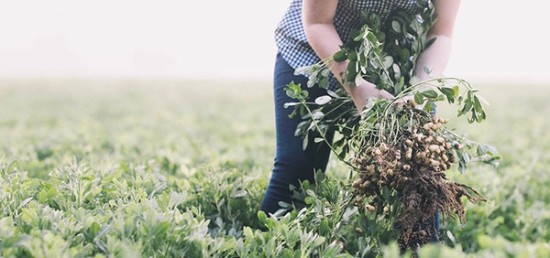It is easy to talk about peanuts and sustainability. Peanuts are a naturally sustainable crop and one of nature’s original “zero-waste” plants. From roots to shells, every part is utilized throughout the planting, growing, harvesting and production process. Peanuts are water efficient and enrich the soil with fertilizer; farmers are producing more peanuts on the same land with fewer inputs.
Plus, many of today’s peanut growers are multigenerational—honoring the past and preparing their land to produce food and fiber for the future generations. It doesn’t get much more sustainable than that. Read on for more about peanuts and sustainability and discover what makes the humble peanut a sustainability star.
How much water does it take to produce one ounce of peanuts?
It takes 3.2 gallons of water to produce one ounce of peanuts. Efficient water usage is strongly connected to peanuts and sustainability. The deep roots of the peanut plant allow the crops to seek water from deep in the soil. Most peanut fields are non-irrigated and rely solely on rainwater. Because of this, they have one of the smallest carbon footprints of any nut. Peanut plants are also hardy during water shortages because they can pause their growth and consume less water in times of drought.

This water footprint chart shows how many gallons of water are used to produce an ounce of each major nut in the United States. Peanuts have the smallest water footprint, using 3.2 gallons of water to produce one ounce. While most major nuts are water efficient, tree nuts require significantly more water than peanuts. Almonds use 28.7 gallons of water, pistachios use 23.6 gallons of water and walnuts use 26.7 gallons of water.
Are peanuts sustainable?
Peanuts and sustainability go hand in hand. Peanut farmers are making continuous improvements in water conservation, chemical reduction and land resource management. When comparing the carbon footprint of nuts, peanuts have one of the smallest.
Through the new Peanut Trust Protocol program from the American Peanut Council, sustainability and conservation practices that peanut farmers are already doing (e.g., low- or no-tillage, GPS usage, irrigation control) will be captured and sustainability improvements will be tracked over time
When looking at the sustainability of nuts, peanuts (which are botanically a legume) shine because they have the unique ability to improve the soil in which they grow. Peanuts are nitrogen fixing, which means the plant takes nitrogen from the air and turns it into food. Because of that, peanut plants do not need a lot of extra fertilizer and are able to rely on the nutrition left by previous crops. After peanut harvest, the plant matter in the field is often reincorporated into the soil to provide a head start on nutrition for the next crop planted. Farmers utilize peanuts as a rotation crop because peanuts add to the soil, rather than taking away.
Peanuts are efficient users of resources requiring less water, fertilizers and pesticides, which means peanut production has a reduced carbon footprint.
Do peanuts use regenerative agriculture?
Regenerative agriculture has not yet been clearly defined. But at its core, regenerative ag is about soil health – keeping carbon in the ground, reducing tillage, using cover crops and increasing biodiversity. Regenerative agriculture is tied to peanuts and sustainability as both organic and conventional peanut farmers use regenerative practices.
What surprising ways are peanut byproducts used?
Peanut vines, peanut roots, peanut shells and peanut oil all play a part in peanuts and sustainability. Scientist and researcher George Washington Carver is well known for inventing and promoting hundreds of uses for all parts of the peanut, including publishing How to Grow the Peanut and 105 Ways of Preparing It for Human Consumption in 1917.
When peanuts are harvested, they are separated from the green, vine-like plants from which they grow. The vines can be turned into organic fertilizer for subsequent crops, or they can be dried to make legume-based hay for cattle, goats and pigs. This hay carries many of the same properties as alfalfa at a much lower cost.
Peanut hulls—the fibrous, crunchy shell that house the peanut kernels—can be turned into pellets for a variety of applications like absorbents, soil additives and even as a source of biofuel. Peanut pellets can be used as a renewable source of biofuel that help contribute to energy production, reduce waste by repurposing discarded hulls and reduce use of non-renewable energy resources.
Peanut shells or peanut hulls can also be composted. Compost is a mixture of “browns” (branches, twigs, leaves, etc.), “greens” (grass clippings, vegetable and fruit trimmings, etc.) and water. The ever-versatile peanut can be a valuable addition to compost as a “brown” ingredient. The carbon that peanuts contain acts as a valuable energy source for the microorganisms that help break down compost.
Peanut oil can be used in cooking and it also has commercial uses. Soap can be made from peanut oil. Peanut oil also has potential as biodiesel to offset conventional diesel fuel use and cost.
Can you grow your own peanuts at home?
Yes, you can see peanuts and sustainability in action by growing your own peanuts at home. Don’t worry if space for a traditional garden is limited (or nonexistent). Peanuts are a hardy plant that can grow on a deck, patio, windowsill or countertop in a container. A single peanut plant can easily produce a bountiful harvest of 30-40 delicious nuts. Learn how to grow your own peanuts at home.
